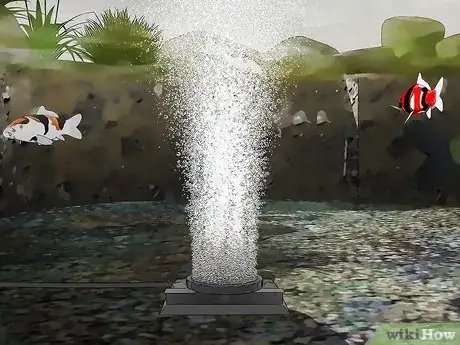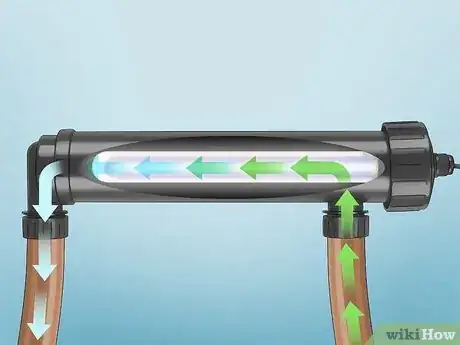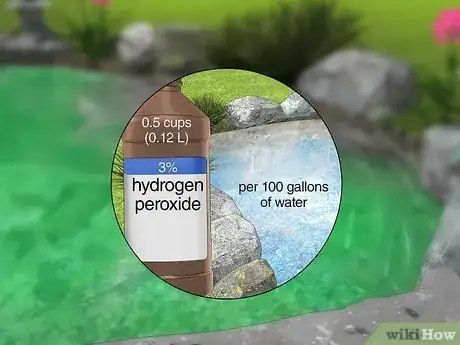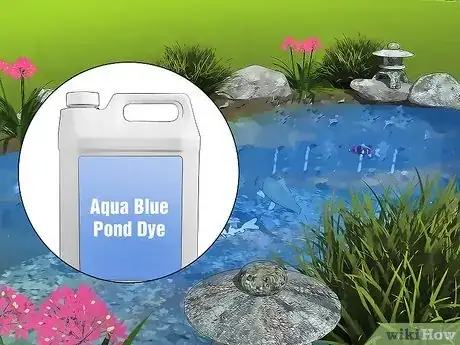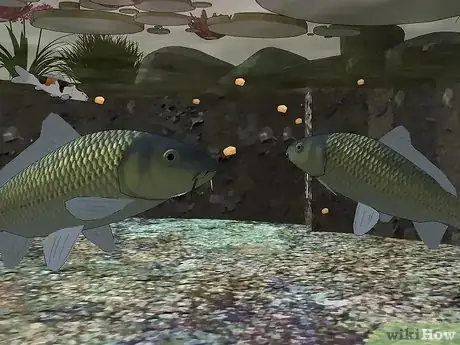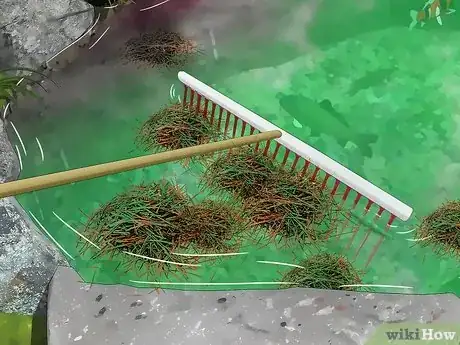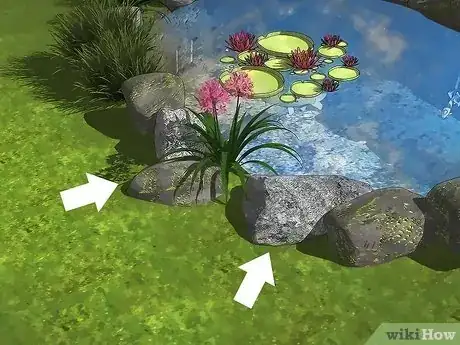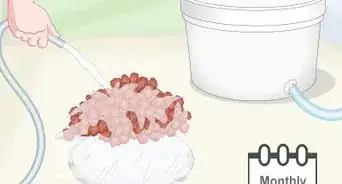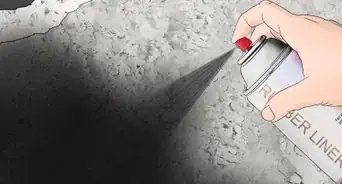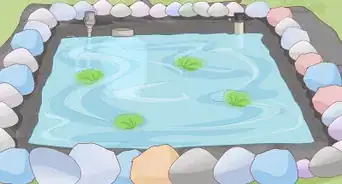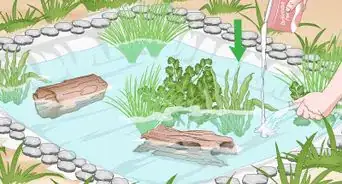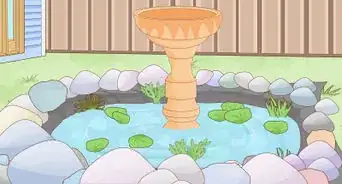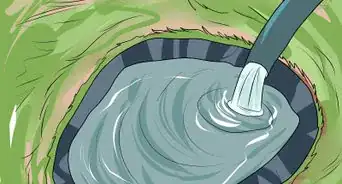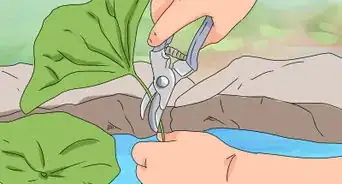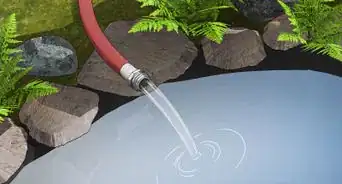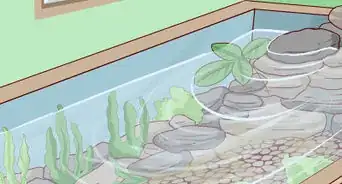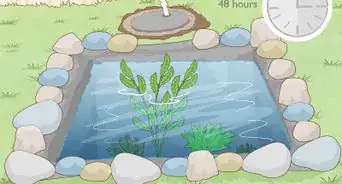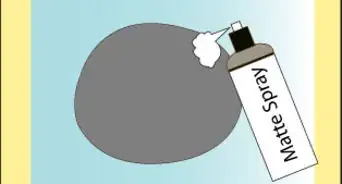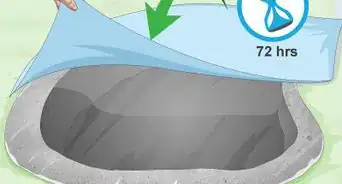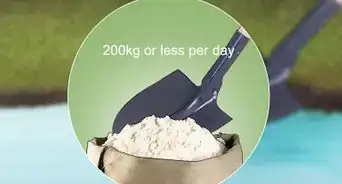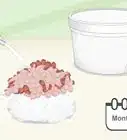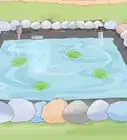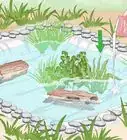This article was co-authored by Doug Ludemann and by wikiHow staff writer, Dan Hickey. Doug Ludemann is the owner and operator of Fish Geeks, LLC, an aquarium services company based in Minneapolis, Minnesota. Doug has worked in the aquarium and fish-care industry for over 20 years, including having worked as a professional aquarist for the Minnesota Zoo and Shedd Aquarium in Chicago. He received his Bachelor of Science in Ecology, Evolution, and Behavior from the University of Minnesota.
There are 10 references cited in this article, which can be found at the bottom of the page.
This article has been viewed 11,344 times.
There are a lot of methods and products to remove algae from a pond, but which ones are safe for the fish swimming below? Algaecides contain harsh chemicals that you’ll want to avoid, but thankfully there are a variety of safer ways to clear up algae. We’ve put together a thorough list of effective ways to remove stringy and microscopic algae from a pond without harming fish, as well as simple prevention methods to keep the algae away. If you’re ready to clear up your pond, read on!
Steps
Expert Q&A
-
QuestionHow do you prevent algae in ponds?
 Scott JohnsonScott Johnson is the Owner and Lead Design Consultant for Concrete Creations, Inc., an award-winning landscape and design company based in the San Diego, California metro area. He has over 30 years of experience in the pool and landscape construction industry and specializes in large estate outdoor environment construction projects. His work has been featured in San Diego Home & Garden Magazine and on Pool Kings TV Show. He earned a BS degree in Construction Management with an emphasis in Architecture and CAD design from Northern Arizona University.
Scott JohnsonScott Johnson is the Owner and Lead Design Consultant for Concrete Creations, Inc., an award-winning landscape and design company based in the San Diego, California metro area. He has over 30 years of experience in the pool and landscape construction industry and specializes in large estate outdoor environment construction projects. His work has been featured in San Diego Home & Garden Magazine and on Pool Kings TV Show. He earned a BS degree in Construction Management with an emphasis in Architecture and CAD design from Northern Arizona University.
Landscape & Design Consultant Pond algae is caused by the sun, so you'll need to treat your water to prevent it from growing. Add an algaecide that's labeled as being safe for fish to the water. The best time to add the algaecide is April, but you can use it at other times, as well. Because the sun is out more in spring and summer, algae is most like to grow during this part of the year.
Pond algae is caused by the sun, so you'll need to treat your water to prevent it from growing. Add an algaecide that's labeled as being safe for fish to the water. The best time to add the algaecide is April, but you can use it at other times, as well. Because the sun is out more in spring and summer, algae is most like to grow during this part of the year.
References
- ↑ https://www.clemson.edu/extension/water/stormwater-ponds/problem-solving/aquatic-weeds/algae-filamentous/index.html
- ↑ https://njaes.rutgers.edu/fs1171/
- ↑ https://charlottenc.gov/StormWater/SurfaceWaterQuality/Documents/Aquatic%20Pesticides%20Info/AlgaeMosquitoControlPonds.pdf
- ↑ https://www.canr.msu.edu/news/preserve_your_natural_backyard_pond
- ↑ https://extension.illinois.edu/blogs/good-growing/2020-07-10-algae-growth-ponds
- ↑ http://qualitywaterexpert.com/uv-filters-for-ponds/
- ↑ https://www.extension.purdue.edu/extmedia/ho/ho-247-w.pdf
- ↑ https://www.canr.msu.edu/news/preserve_your_natural_backyard_pond
- ↑ https://www.canr.msu.edu/news/preserve_your_natural_backyard_pond
- ↑ https://www.bbc.co.uk/gardening/basics/techniques/ponds_care1.shtml
- ↑ https://www.petcoach.co/article/why-overfeeding-fish-is-a-problem-and-how-to-avoid-it/
- ↑ https://www.bbc.co.uk/gardening/basics/techniques/ponds_care1.shtml
- ↑ https://www.canr.msu.edu/news/preserve_your_natural_backyard_pond
- ↑ https://www.canr.msu.edu/news/how-much-water-is-in-my-pond



